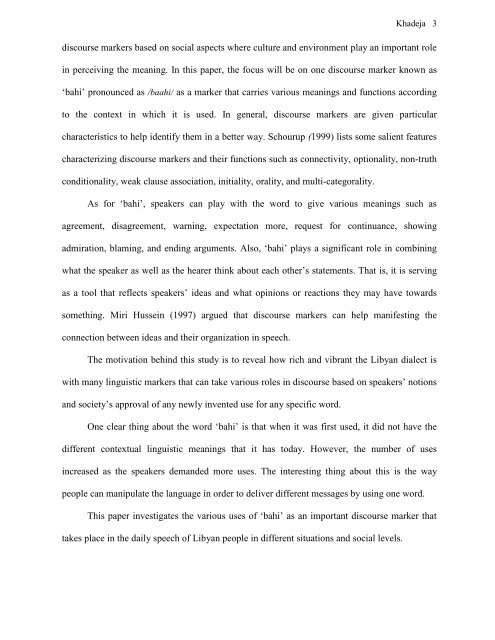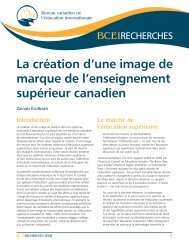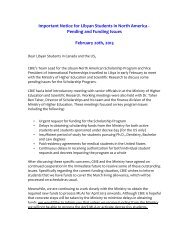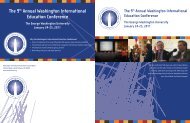Bahi-as-a -Discourse -Marker-in-Daily -Libyan-Arabic
Bahi-as-a -Discourse -Marker-in-Daily -Libyan-Arabic
Bahi-as-a -Discourse -Marker-in-Daily -Libyan-Arabic
You also want an ePaper? Increase the reach of your titles
YUMPU automatically turns print PDFs into web optimized ePapers that Google loves.
Khadeja 3discourse markers b<strong>as</strong>ed on social <strong>as</strong>pects where culture and environment play an important role<strong>in</strong> perceiv<strong>in</strong>g the mean<strong>in</strong>g. In this paper, the focus will be on one discourse marker known <strong>as</strong>‘bahi’ pronounced <strong>as</strong> /bɑahi/ <strong>as</strong> a marker that carries various mean<strong>in</strong>gs and functions accord<strong>in</strong>gto the context <strong>in</strong> which it is used. In general, discourse markers are given particularcharacteristics to help identify them <strong>in</strong> a better way. Schourup (1999) lists some salient featurescharacteriz<strong>in</strong>g discourse markers and their functions such <strong>as</strong> connectivity, optionality, non-truthconditionality, weak clause <strong>as</strong>sociation, <strong>in</strong>itiality, orality, and multi-categorality.As for ‘bahi’, speakers can play with the word to give various mean<strong>in</strong>gs such <strong>as</strong>agreement, disagreement, warn<strong>in</strong>g, expectation more, request for cont<strong>in</strong>uance, show<strong>in</strong>gadmiration, blam<strong>in</strong>g, and end<strong>in</strong>g arguments. Also, ‘bahi’ plays a significant role <strong>in</strong> comb<strong>in</strong><strong>in</strong>gwhat the speaker <strong>as</strong> well <strong>as</strong> the hearer th<strong>in</strong>k about each other’s statements. That is, it is serv<strong>in</strong>g<strong>as</strong> a tool that reflects speakers’ ide<strong>as</strong> and what op<strong>in</strong>ions or reactions they may have towardssometh<strong>in</strong>g. Miri Husse<strong>in</strong> (1997) argued that discourse markers can help manifest<strong>in</strong>g theconnection between ide<strong>as</strong> and their organization <strong>in</strong> speech.The motivation beh<strong>in</strong>d this study is to reveal how rich and vibrant the <strong>Libyan</strong> dialect iswith many l<strong>in</strong>guistic markers that can take various roles <strong>in</strong> discourse b<strong>as</strong>ed on speakers’ notionsand society’s approval of any newly <strong>in</strong>vented use for any specific word.One clear th<strong>in</strong>g about the word ‘bahi’ is that when it w<strong>as</strong> first used, it did not have thedifferent contextual l<strong>in</strong>guistic mean<strong>in</strong>gs that it h<strong>as</strong> today. However, the number of uses<strong>in</strong>cre<strong>as</strong>ed <strong>as</strong> the speakers demanded more uses. The <strong>in</strong>terest<strong>in</strong>g th<strong>in</strong>g about this is the waypeople can manipulate the language <strong>in</strong> order to deliver different messages by us<strong>in</strong>g one word.This paper <strong>in</strong>vestigates the various uses of ‘bahi’ <strong>as</strong> an important discourse marker thattakes place <strong>in</strong> the daily speech of <strong>Libyan</strong> people <strong>in</strong> different situations and social levels.
















